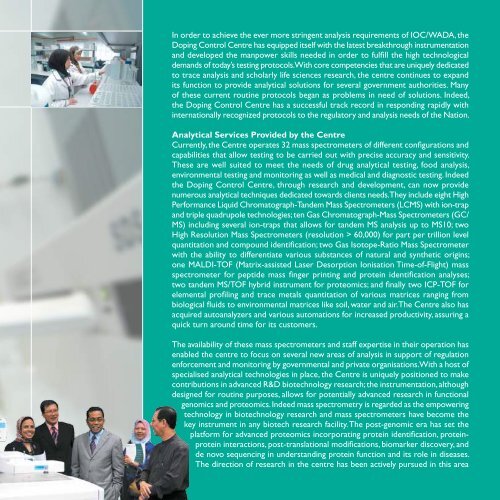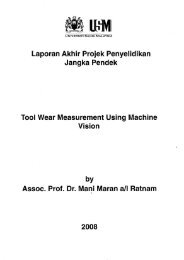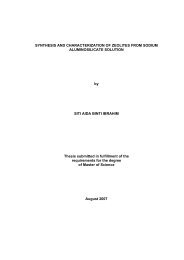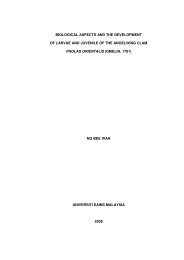Research Institutes, Centres and Units - Universiti Sains Malaysia
Research Institutes, Centres and Units - Universiti Sains Malaysia
Research Institutes, Centres and Units - Universiti Sains Malaysia
Create successful ePaper yourself
Turn your PDF publications into a flip-book with our unique Google optimized e-Paper software.
In order to achieve the ever more stringent analysis requirements of IOC/WADA, the<br />
Doping Control Centre has equipped itself with the latest breakthrough instrumentation<br />
<strong>and</strong> developed the manpower skills needed in order to fulfill the high technological<br />
dem<strong>and</strong>s of today’s testing protocols. With core competencies that are uniquely dedicated<br />
to trace analysis <strong>and</strong> scholarly life sciences research, the centre continues to exp<strong>and</strong><br />
its function to provide analytical solutions for several government authorities. Many<br />
of these current routine protocols began as problems in need of solutions. Indeed,<br />
the Doping Control Centre has a successful track record in responding rapidly with<br />
internationally recognized protocols to the regulatory <strong>and</strong> analysis needs of the Nation.<br />
Analytical Services Provided by the Centre<br />
Currently, the Centre operates 32 mass spectrometers of different configurations <strong>and</strong><br />
capabilities that allow testing to be carried out with precise accuracy <strong>and</strong> sensitivity.<br />
These are well suited to meet the needs of drug analytical testing, food analysis,<br />
environmental testing <strong>and</strong> monitoring as well as medical <strong>and</strong> diagnostic testing. Indeed<br />
the Doping Control Centre, through research <strong>and</strong> development, can now provide<br />
numerous analytical techniques dedicated towards clients needs. They include eight High<br />
Performance Liquid Chromatograph-T<strong>and</strong>em Mass Spectrometers (LCMS) with ion-trap<br />
<strong>and</strong> triple quadrupole technologies; ten Gas Chromatograph-Mass Spectrometers (GC/<br />
MS) including several ion-traps that allows for t<strong>and</strong>em MS analysis up to MS10; two<br />
High Resolution Mass Spectrometers (resolution > 60,000) for part per trillion level<br />
quantitation <strong>and</strong> compound identification; two Gas Isotope-Ratio Mass Spectrometer<br />
with the ability to differentiate various substances of natural <strong>and</strong> synthetic origins;<br />
one MALDI-TOF (Matrix-assisted Laser Desorption Ionisation Time-of-Flight) mass<br />
spectrometer for peptide mass finger printing <strong>and</strong> protein identification analyses;<br />
two t<strong>and</strong>em MS/TOF hybrid instrument for proteomics; <strong>and</strong> finally two ICP-TOF for<br />
elemental profiling <strong>and</strong> trace metals quantitation of various matrices ranging from<br />
biological fluids to environmental matrices like soil, water <strong>and</strong> air. The Centre also has<br />
acquired autoanalyzers <strong>and</strong> various automations for increased productivity, assuring a<br />
quick turn around time for its customers.<br />
The availability of these mass spectrometers <strong>and</strong> staff expertise in their operation has<br />
enabled the centre to focus on several new areas of analysis in support of regulation<br />
enforcement <strong>and</strong> monitoring by governmental <strong>and</strong> private organisations. With a host of<br />
specialised analytical technologies in place, the Centre is uniquely positioned to make<br />
contributions in advanced R&D biotechnology research; the instrumentation, although<br />
designed for routine purposes, allows for potentially advanced research in functional<br />
genomics <strong>and</strong> proteomics. Indeed mass spectrometry is regarded as the empowering<br />
technology in biotechnology research <strong>and</strong> mass spectrometers have become the<br />
key instrument in any biotech research facility. The post-genomic era has set the<br />
platform for advanced proteomics incorporating protein identification, proteinprotein<br />
interactions, post-translational modifications, biomarker discovery, <strong>and</strong><br />
de novo sequencing in underst<strong>and</strong>ing protein function <strong>and</strong> its role in diseases.<br />
The direction of research in the centre has been actively pursued in this area

















